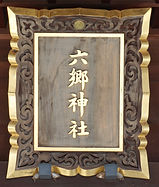普通の外にいくつかの著名な品質を持っている、と畏敬の念を起こさせるあるいかなるビーイングは、カミと呼ばれています。
Nearest station
Zōshiki
Keikyu Main Line
Tōkyō-to, Ōta-ku, Higashi-Rokugō 3-10-18
東京都大田区東六郷3-10-18
六郷神社
Rokugō Jinja
Home page (Japanese)
March 17, 2018
Enshrined Kami:
Main
From Merged Shrines
None
In-ground Shrines:
Tenso Jinja 天祖神社
Hikawa Jinja 氷川神社
Inari Sha 稲荷社
Mihashira Sha 三柱社
Annual Festival: November 24
History
Along with Mita Hachiman Jinja in Minato-ku, and two shrines in Ōta-ku, Hiei Jinja (薭田神社) and Unoki Hachiman Jinja, one of the four candidates to be the Hiei Jinja mentioned in the Engi-shiki.
This shrine’s origins may date back to 1057. In that year the father/son team of Minamoto Yoriyoshi and Yoshiie hung their white battle flag on the top of a large cedar tree close to the current site of the shrine to help attract more troops for the Former Nine Years’ War campaign. They had prayed at Kyōto’s Iwashimizu Hachimangū for continuing military success, and after their triumphal return from the campaign the shrine was founded as an offshoot of the Kyōto shrine through the bunrei process.In 1189, another Morimoto, Yoritomo, following the


precedent set by his ancestors, raised the clan’s white battle flag and prayed for success prior to setting out on his successful campaign to subdue the two Northern provinces of Mutsu and Dewa. In 1191, sometime after his victorious
return and the year before he became Japan’s first Shōgun, he ordered Kajiwara Kagetoki to build a main hall at what is now Rokugō Jinja. Among the shrine’s treasures kept in the main hall are a female lion mask; this was donated by Yoritomo, as was the water purification stone in the shrine’s grounds, while the small arched bridge in front of the main torii is said to have been donated by Kajiwara.
In 1591 Tokugawa Ieyasu granted the shrine a trading license worth 18 koku. In 1600 he had a prayer read at the shrine for the successful completion of the Rokugō Bridge which was built in that year, and the jinja’s portable shrine was used in a ceremony to commemorate the first crossing of the bridge.
During the Edo Period the shrine came to be known as Rokugō Hachiman- Gū, and its betto-ji was the Hōshu-in temple, now located nearby at Nakarokugō 4-34-8. A document survives which tells us that originally the jinja enshrined the three Hachiman Kami—Hondawake-no-mikoto, Jingū Kōgō, Hime-Ōkami—but following untoward incidents at a festival which saw one of the portable shrines drift off in the direction of Kazusa Province and another of them buried underground after its kami uttered a series of curses, two of the kami were disenshrined leaving only Hondawake-no-mikoto. As this document is dated 1719 and also states that the three kami were still enshrined in that year these incidents must have taken place subsequently.
In 1872 the shrine was given the rank of village shrines and in 1876 the current name, Rokugō Jinja, was adopted.
Description
There is a lot to see in this shrine but for me pride of place must go to the koma-inu pair to be seen about 100 metres on the left after passing through the torii at the rear of the jinja. They date to 1685, making them the oldest in Ōta-ku.
(Click on images to expand them)





















